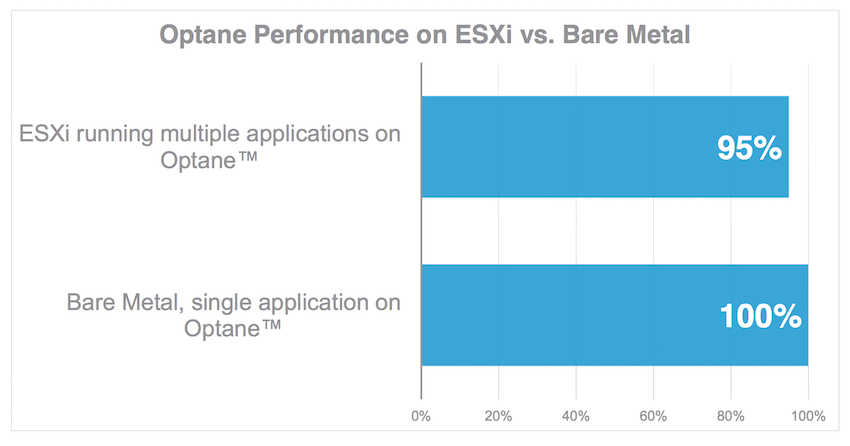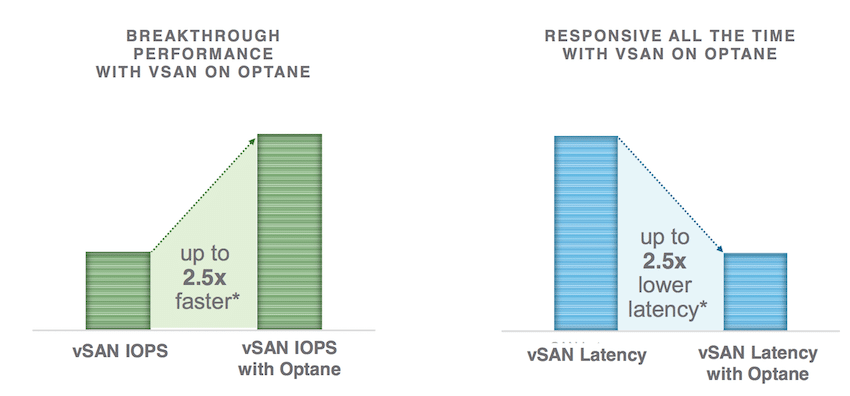Intel launched its first Optane-based product for the enterprise last week, the Optane SSD DC P4800X series. Summarizing of the technical details, the P4800X in its first incarnation is a 375GB SSD in an add-in-card form factor. Software defined solutions like VMware vSAN are uniquely qualified to take full advantage of this new technology, as they're already architected to leverage advancements in hardware. VMware has done just that, offering launch support in both ESXi 6.5 and vSAN 6.5.
Intel launched its first Optane-based product for the enterprise last week, the Optane SSD DC P4800X series. Summarizing of the technical details, the P4800X in its first incarnation is a 375GB SSD in an add-in-card form factor. Software defined solutions like VMware vSAN are uniquely qualified to take full advantage of this new technology, as they're already architected to leverage advancements in hardware. VMware has done just that, offering launch support in both ESXi 6.5 and vSAN 6.5.
At the launch event for Optane last week, VMware presented a tease of early data showing what the P4800X can do when acting as the cache drive in vSAN. vSAN can configure disk pools in a variety of ways, but essentially some number of lower cost drives sit behind the read and write cache drive. In this case what the P4800X brings to the table is a very fast cache; one that easily beats out existing SAS and PCIe interface solutions. While a fully populated vSAN node would want multiple P4800X SSDs and sizing would likely suggest a larger capacity cache drive, there's only a 375GB option today. That said, paired with 7 capacity drives and a single P4800X per node, vSAN posts some impressive numbers with no alterations to vSAN software.
First we take a look at ESXi, where it's understood that the hypervisor has a "performance cost" associated with it. The P4800X in bare metal running a single application is the standard, setting a bar for top-end expectations. In ESXi running multiple applications, there's just a 5% drop. To be fair, Intel and Vmware didn't disclose the testing scenario, but both are very cautious about releasing performance data so this data could fairly be considered to show a very low overhead impact for ESXi.
Turning to vSAN performance now, the infusion of the P4800X shows tremendous gains in both IOPs and latency when compared to the Intel P3700 NAND-based NVMe SSD. The workload applied in this case is 100% sequential writes, 64KB IP with a 1/7 disk group. Certainly this type of workload isn't standard in the HCI universe, but the data does reveal that there are clearly gains to be had by doing nothing other than swapping out a typical NAND-based SSD for the Optane-based P4800X.
VMware sees this new class of Optane SSDs as a vehicle to help increase vSAN's utility when it comes to big data analytics, business critical apps and VDI (amongst others). In these environments though the cache is much more active than the use case above, so it remains to be seen just what the P4800X can do when under a diverse load. The potential is promising though, considering the P4800X is just a drop in card with nothing new required at the node or vSAN level. For its part, VMware has done well to show their customers that new technology can be easily included in their HCI stack.


